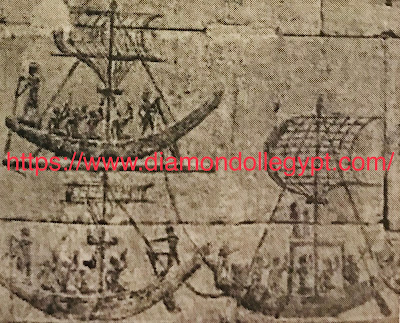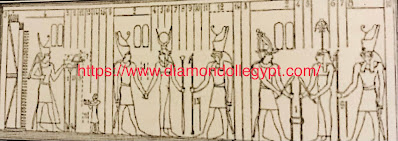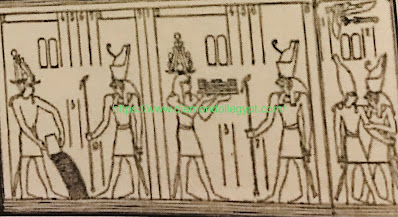The inscriptions on the walls in the open courtyard ( behind the columns)
Edfu Temple
The scenes are carved in 4 horizontal rows, and they represent the king while he was performing the religious rituals.
The inscriptions of the first row on the eastern wall of the southern porch :
The events represent the annual journey of Hathor’s arrival from her temple in Dendera across the river using sailboats ( to the temple of Edfu ) in order to visit her husband Horus.
We see two boats: the boat of Hathor and the boat of Horus ( above them the goddess of protection ( Nekhbet ) and ( wadjet) , and we also see the winged sun disk ( Horus ).
How do we know that this trip is the arrival and not the return trip ?
Boats with open sails use the north winds to move them south , Dendera in the north and Edfu in the south.
Inside the boat we find the sailors and priests of the temple of Hathor as well as we find many offerings and gifts that will be offered from the Temple of Dendera to the Temple of Edfu.
We also find a row of priests in the Temple of Edfu waiting to receive the procession of Hathor.
3 dancers also appear carrying a ( Tambourine ) in order to celebrate and welcome the Hathor procession.
On the opposite side ( west wall ) :
We find almost the same scenes, but it represents the journey of Hathor’s return to her temple in Dendera.
But the only difference here is that the sail of the boat is folded as the boat on the return trip does not need wind. The boat automatically goes with the Nile River current from south to north.
Views of the king on the south porch:
Ptolemy XII, the father of Cleopatra VII, exits the palace wearing the white crown ( Upper Egypt).
Pictured in a larger size, in front of him is a priest pictured in a smaller size, and in front of them the gods : Thoth , Abis , Horus ( falcon ), Anubis ( jackal ) and Osiris.
After that scene, we find another scene, which is the purification process of the king and it is carried out by the two deities, Horus and Jahuti. Then this scene is followed by a third scene, which is the scene of the coronation.
And here it must be said that the coronation process is only carried out by the king while he is pure.
In the scene of the coronation we see the two goddesses Wadegat wearing the red crown (lower Egypt) represented by the cobra and the goddess Nekhbet wearing the white crown ( Upper Egypt ) represented by ( the female eagle ). Wadget and Nekhbet are the two deities responsible for the coronation of the king.
Then we see another view:
The king wears a crown ( atef ) and Horus of Edfu gives him the scepter ( military strength).
Then we see Horus ( Sematawi ) ( unifying the two lands ) and he puts the ankh sign of life on the nose of the king in the presence of Horus Edfu.
In the second row, we see the scene of the Tree of Life, which is the archaic tree, which is one of the local trees in Egypt and is considered one of the sacred trees in ancient Egypt.
The most important thing that we should know here is that these scenes are symbolic, they were not actually happening as Ptolemy XII, father of Cleopatra VII, did not visit the temple at all, but was represented by the high priest.
Scene are in five horizontal rows
Views are in five horizontal rows.
The first row from the bottom: repeated images of the Nile gods : Habi and the goddess of grain and good deeds ( Sikhti ) bearing over her head the symbols of the different regions of Upper and Lower Egypt.
Second row : view of the lake of fire .
Scenes symbolizing reward and punishment, as we see the king standing and stabbing a group of prisoners with their arms and legs tied .
After killing the captives, they go to punishment in the hereafter by throwing them into the lake of fire.
Lake of fire : it is visualized on the wall in the form of a square hanging above it, 3 incinerators, the symbol of fire in ancient Egypt. These events take place under the supervision of Habi and Anubis.
Then we see different scenes of king Ptolemy XII wearing several different crowns in front of Horus Edfu and Hathor and in those scenes the king makes offerings.
Western wall :
The same previous scenes are repeated .
Scenes of the north wall
It represents the facade of the main temple. And these are 6 scenes of all of King Ptolemy the second ( Urgits ) while he was making offerings to the gods of the temple.
Empty cartridge scene
There are many rectangular cartouches on the wall of this hall without names. These cartridge must have the king’s name, but why is there no name ?
Because the ancient Egyptians did not know Greeks’ God, because the gods of the ancient Egyptians were different from Greece’s and the protector of the ancient Egyptians was called Horus, the protector of the Greeks was called Apollo, so the king was a name that was not written.
Arabic writings next to the hieroglyphic inscriptions:
The Arabic writings engraved in bas-relief are the signature of the engineers and assistants to the pioneer of astronomy in the modern era ( Mahmoud Pasha ) the astronomer in the late nineteenth century when it was his habit at that time to ascend the tops of buildings and do area measurements and upon completion had to sign the names in order to remind them that they had risen by making measurements from the top of this building.
Mahmoud Pasha is an astronomer who has many books related to astronomy, including the Gregorian calendar book and the corresponding Hijri calendar, the Old Alexandria book in French, and he has an Arabic translation and the book of measurements of the Great Pyramid astronomically and many others.
Archaeological awareness at the time was not so intense today, and the antiquities were not of their importance to us today.
Hypo style ( The columns hall ) :
It consists of 12 columns carrying the ceiling 6 columns on the right and 6 columns on the left between them is a corridor . The most important thing that distinguishes them is the enormity. When that hall was built it was all colored, whether the columns or the walls and the ceiling. There is nothing left but a few colors . To the right of the hall we see a small prominent room ( the library) which is dedicated to storing papyrus scrolls. Above the library room we see the signs of the five senses in hieroglyphic language ( hearing , sight , perception, touch and smelling ).
Inside the library there are many inscriptions, such as making offerings to the gods, the king kills his enemies, and we see the enemy here in the form of a hippopotamus. We also see the cartouches of king Ptolemy IX , as we see 2 gap ( two holes ) used to store papyrus scrolls.
On the walls of the library’s wall, we also see the names of some books, including: six Gods of Evil. Protecting the King’s Bedroom. The book to repel the Crocodile. Books to expel snakes. The book of titles . The Art of engraving the wall. The book of protecting the body . The book of protecting the king in his home . The book of expelling Evil Eyes.
We also see a scene of the king killing the god Seth in the form of a donkey.
We also see the sight of the king throwing the enemies into the lake of fire ( Hell ).
Purification room :
And it is the room opposite the library ( a room on the left in the great hypostyle hall ).
In those, the king is purified symbolically.
The high priest performs these rituals on behalf of the king ( the king used to reside in Alexandria).
While the priests are cleansed in the Holy Lake 3 times a day.
The room contained golden utensils used in celebrations.
And the use of these utensils:
She ( water pots , milk pots , wine vessels )
The inscriptions of that room express the king’s purification in front of the god Horus Edfu and the god Thoth.
Inscriptions of the Column Hall
And they are the inscriptions of the foundation of the temple.
The king leaves his palace under the protection of Horus.
He digs the foundation of the temple, and in his hand is an ax.
The king also appears with Horus Edfu as he cleanses the temple with Nitron salt to expel evil spirits. And it is a habit that continues until now in Egypt, especially in Upper Egypt, called salt sprinkling.
Then we see the king presenting the temple building documents to the god Horus.
Look carefully, the first scene has the king Ptolemy and the god Horus.
Because in a dream, the god Horus asked the king to build him a temple.
The second picture shows king Ptolemy’s loyalty as he is in front of Horus and his wife , promising ( I will you a temple soon ).
In the third pattern, King Ptolemy in front of Horus and the goddess Seshat.
By looking at the goddess’ head with ( two horns ) as an activation symbol, being responsible for choosing the location and size of the temple, so the king should start construction with goddess help.
In the fourth pattern, King Ptolemy began laying the first stone for the temple and his wife laying sand.
After the construction, you will see the god Horus embracing King Ptolemy in the fifth type , showing God Horus’ happiness, as he wants to thank the king. So God Horus wants to hug him, expressing his thankfulness “ I love you so much, thank you for building this temple for me “.
Views of the north wall in the hypostyle hall :
Consists of 4 horizontal rows.
The king in the lower first row wears the double crown and makes offerings to Horus.
Interpretation of the black color in the first and second halls in the roof of the temple:
First opinion
It is that this black color is a result of the smoke of the fires that were used by the inhabitants of the temple ( Christians ) for cooking or for heating. There is also another opinion that Christians used fires in their religious rituals.
Second opinion
That this black color is the result of the fire that the Romans lit in the temple.
Third option:
The colors engraved on the ceiling had fungi and these fungi over time turn black.
After the spread of Christianity and the end of the Roman era, the temple was completely buried under the sand and houses were built above it for peasants and this is fortunate as the was preserved and is now in good condition.
Hypo style ( The columns hall II )
There are 12 stone columns, 6 stone columns on each side in the second portico.
Hall names: Transfiguration Hall, Celebrations Hall.
The function of the wall : the place of residence of the boats of the gods during the celebration of the holidays. So we see pictures of the boats of the gods on the walls of that hall, left and right.
The priests wanted to preserve the rituals of the ancient Egyptian religion for fear of extinction, especially in light of the presence of foreign rulers, so they wrote on the walls of that hall left and right a lot of those rituals , but they wrote them in a very complicated way that is difficult to understand, writing the rituals of the foundation of the temple.
We are still in the small hall and we find on the right two doors a door leading to the main sacred corridor of the temple and a door leading to the room of rigid offerings such as bread, pancakes and sweets, as precious stones were also stored in it , all the scenes recorded on the walls are : Offerings scenes made of jewelry, gold, silver and decorative tools, as well as engraved instructions and religious rituals for young priests to teach them.
On the left, there are two doors : a door leading to the holy corridor, there is another door leading to the sacred water room. Where we find inscriptions of that room representing the god Habi and he offers the king holy water and also presents it to the temple god Horus Edfu and Hathor.
The second door in the hall of the small pillars leads to the room of the laboratory and perfumes, and the inscriptions of that room are very complex, representing about 150 prescriptions for the type of perfumes, ointments and incense. The goal was not trafficking , but those prescriptions private only for the temple.
The inscriptions of that room represent the king as he gifted perfumes to the deities, which may take about 15 days to be made in order to retain their aroma.
These inscriptions, as I said, are nothing but compositions for perfumes, which served as instructions for priests to know what are the exact ingredients and the correct way to make perfumes.
The French Egyptologist August Mariette, who discovered this temple, photographed those aromatic prescriptions and transported them to France and now, thanks to those prescriptions, France is the first country in perfumery in the whole world.
Transfiguration hall in the temple
Two chapels, where the priests conduct ritual worship to the gods.
Offerings hall :
And in it all offerings are collected before they enter the Holy of Holies.
This hall is connected to the roof of the temple by two ladders. A spiral staircase in the east is used for ascending. A straight staircase in the west is used for descending. Wall inscriptions describe lists of offerings made to the goddess of good things in Egypt (Sikhti) responsible for feeding the people of Egypt. This goddess appears in the form of cows, calves and rams.
Inscriptions on the walls of the Ascension staircase depict the priests carrying statues and ascending to the roof of the temple.
The inscriptions on the walls of the landing staircase depict the priests carrying statues and going down again to the offering hall.



Comments
Post a Comment